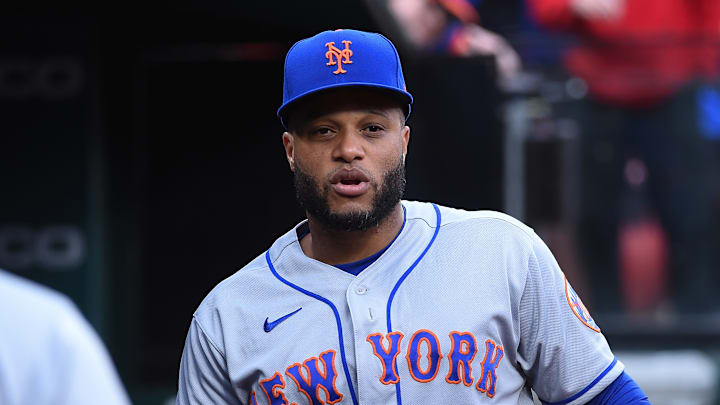New York Mets fans finally got to say “good riddance” to Robinson Cano. Cano had become the latest target of ire of Mets fans and the media. So saying goodbye was easy. Costly…but easy.
Cano was on a trajectory to the Hall of Fame. And, ok, he got hit with an 80-game suspension when he was with the Seattle Mariners. And, ok, that might have hindered his chances of getting elected to the Hall. But that didn’t deter Brodie Van Wagenen, who would take his one-time client as part of a salary dump in his desire to acquire closer Edwin Diaz from the Mariners.
At the age of 36, and coming off the 80-game suspension, Cano would have the worst season of his career in his first season as a Met. Of course he did. That is what happens to All Star second basemen when they come to the Mets…just ask Robert Alomar, Carlos Baerga, Juan Samuel. Cano hit .256 with 13 homers and 39 RBI and managed to stay on the field for only 107 games in 2019 due to various nagging injuries.
Cano rebounded in the shortened 2020 season, hitting .316 with 10 homers and 30 RBI in just 49 games.
But then came the shocking news as Cano was suspended for the entire 2021 season for a second violation of the Major League Baseball illegal substance policy.
Cano’s return for the 2022 season became fodder for the fans and media, with speculation surrounding whether the Mets would keep him around. It would have been an easy decision had Cano flopped immediately. However, he had a strong spring training and he remained popular in the clubhouse. And given his pedigree, and the “win now” philosophy of the Mets, and the permanent addition of the DH in the National League, it made sense to keep the aging one-time superstar.
But once the season began, so did the headache. Cano did not perform well enough to keep him the lineup and justify keeping others off the field. But what to do with him? Cano was still owed over $40 million. That’s a huge amount of money. The Mets made the decision to cut their losses and cut Cano.
The New York Mets disposed of a big contract and a huge headache before.
The 1986 Mets were brash. Fun to watch because they WERE brash. But when George Foster was brash and accused the Mets of racism, it put a damper on what, by all accounts, was a perfect season for the Mets.
Foster became popular when he broke out as a home run hitter for the Big Red Machine, as part of a star-studded lineup that included Hall of Famers Johnny Bench, Joe Morgan, and Tony Perez, in addition to Pete Rose and Ken Griffey. He had a monster year in 1977 when he led the Major Leagues with 52 dingers and 149 runs batted in. The next highest HR total that year was Texas Rangers Jeff Burroughs 41 homers.
By the time the Mets acquired Foster prior to the 1982 season, Foster was 33 years old and already in decline. Although the Mets acquired Foster in a trade, the Mets had to first give Foster a new five-year $10 million contract to approve the trade. That made him the second highest paid player behind only New York Yankee Dave Winfield.
His first year in a Mets uniform didn’t endear himself to the media nor the fans, as he hit .247 with 13 home runs and 70 RBI. He was never a great fielder and playing in Shea Stadium with the tricky air currents made him appear even worse.
Foster would rebound, a bit, averaging 24 homers and 84 RBI over the next three seasons, but he declined each year – with 28, 24, and 21 homers respectively, as well as 90, 86, and 77 RBI.
In 1986, at the age of 37, Foster was a shell of himself and struggling. Mets manager made the decision to replace him with rookie Kevin Mitchell who burst onto the scene and would play a huge role during the World Championship season.
But when Foster was forced to the bench, he made public remarks insinuating that the Mets and, specifically, Davy Johnson were racist, suggesting that was the motivation behind the move.
On August 7, 1986, the Mets cut bait with Foster, with approximately $1.7 million still owed to him. Foster. That’s a lot of money back in 1986.
Foster had hit 248 homers in 10 seasons prior to joining the Mets, and hit 99 during his four-plus seasons with the Mets. Based on the average, it would appear his production was steady. But it is truly deceptive. Foster did most of his damage during the four-year span from 1976 through 1979 when he hit 29, 52, 40, and 30 home runs. During that span he hit for a .301 clip and averaged 122 RBI. The rest of his career was rather pedestrian. And when he struggled with the Mets, he was often booed unmercifully.
In a New York Times article published on August 7, 1986, Davy Johnson was quoted as saying, “In the four years he's been here, he's been streaky,'' Johnson added. ''This year, with the emergence of Kevin Mitchell, I couldn't afford the luxury of waiting for George. My job is to put the best nine players out there.''
And that is exactly what the Mets did with Robinson Cano. Hard to believe it was ever done with the Wilpons at the helm, although Nelson Doubleday still had some say back then. But in this new era with Steve Cohen in charge, performance takes precedence over money. And if history, New York Mets history, teaches us anything, putting the best nine players on the field is the winning formula.
